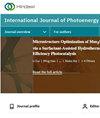Modeling and Simulation of Solid Oxide Fuel Cell Integrated with Anaerobic Digester, Thermal Storage Unit and Solar Collector: A Net Zero Emission System
IF 2.1
4区 工程技术
Q3 CHEMISTRY, PHYSICAL
引用次数: 0
Abstract
Energy production from clean and green sources is one of the eminent challenges to mankind. Overall, all industrial sectors contribute to CO2 emission, but the energy production sector is a major contributor. In recent years, CO2 emissions from the energy sector have increased by 1.7%. Therefore, the development of alternative energy production sources is a pivot for researchers. In this regard, the fuel cell has been a promising technology but still accompanied by the release of greenhouse gasses but relatively lower than that of fossil fuels. The integration of the fuel cell to the biogas has been a promising factor to reduce emissions. This study contributes to the same by producing a self-sustaining biogas-fuel cell multigeneration system for cold areas. Mathematical modeling of all complements of the system, i.e., anaerobic digester, solid oxide fuel cell, solar collector, and thermal storage system, is provided. MATLAB/Simulink environment is used for simulation of the system. The proposed system will use an anaerobic digester for methane production. Hence, produced methane will be used to power solid oxide fuel cell. The electricity of the fuel cell will power the residential place, and the thermal potential of the exhaust will be stored. In daylight, the solar thermal potential will be utilized for district heating. In the absence of solar light, stored thermal energy will be used for district heating and hot water supply. Additionally, the CO2 emitted from the system will not be released into the environment but stored for industrial purposes. The best area of application of the proposed system is cold areas such as Switzerland.厌氧消化池、蓄热单元和太阳能集热器一体化固体氧化物燃料电池的建模与仿真:一个净零排放系统
利用清洁和绿色能源生产能源是人类面临的突出挑战之一。总体而言,所有工业部门都对二氧化碳排放有贡献,但能源生产部门是主要贡献者。近年来,能源部门的二氧化碳排放量增加了1.7%。因此,开发替代能源生产来源是研究人员的一个重点。在这方面,燃料电池是一种很有前途的技术,但仍会释放温室气体,但相对低于化石燃料。将燃料电池与沼气相结合是减少排放的一个有希望的因素。这项研究通过为寒冷地区生产一个可自我维持的沼气燃料电池多代系统来实现这一点。提供了该系统的所有补充,即厌氧消化器、固体氧化物燃料电池、太阳能收集器和储热系统的数学模型。系统仿真采用MATLAB/Simulink环境。拟建系统将使用厌氧消化器生产甲烷。因此,产生的甲烷将用于固体氧化物燃料电池。燃料电池的电力将为住宅供电,废气的热电势将被储存起来。在白天,太阳能热势将被用于区域供暖。在没有太阳能的情况下,储存的热能将用于区域供暖和热水供应。此外,系统排放的二氧化碳不会释放到环境中,而是储存用于工业目的。拟议系统的最佳应用领域是寒冷地区,如瑞士。
本文章由计算机程序翻译,如有差异,请以英文原文为准。
求助全文
约1分钟内获得全文
求助全文
来源期刊
CiteScore
6.00
自引率
3.10%
发文量
128
审稿时长
3.6 months
期刊介绍:
International Journal of Photoenergy is a peer-reviewed, open access journal that publishes original research articles as well as review articles in all areas of photoenergy. The journal consolidates research activities in photochemistry and solar energy utilization into a single and unique forum for discussing and sharing knowledge.
The journal covers the following topics and applications:
- Photocatalysis
- Photostability and Toxicity of Drugs and UV-Photoprotection
- Solar Energy
- Artificial Light Harvesting Systems
- Photomedicine
- Photo Nanosystems
- Nano Tools for Solar Energy and Photochemistry
- Solar Chemistry
- Photochromism
- Organic Light-Emitting Diodes
- PV Systems
- Nano Structured Solar Cells

 求助内容:
求助内容: 应助结果提醒方式:
应助结果提醒方式:


